Unlock the Secrets of Spinning Fishing Rods: Your Ultimate Guide to Catching More Fish!
Fishing is not just a hobby; it’s a passion that connects us to nature and provides a sense of tranquility. At the heart of this experience lies the spinning fishing rod, a crucial tool that can significantly enhance your fishing adventures. Whether you’re a seasoned angler or a novice, understanding the nuances of spinning rods can lead to more successful outings. In this article, we will explore the essential features of spinning fishing rods, the myriad benefits they offer, and practical tips on how to select the right one for your needs. By the end, you’ll be equipped with the knowledge to make informed decisions and improve your fishing experience.

Understanding Spinning Fishing Rods
Spinning fishing rods are designed specifically for use with spinning reels, which are mounted beneath the rod. This setup allows for easy casting and retrieval, making it ideal for anglers of all skill levels. Unlike baitcasting rods, which require more technique and precision, spinning rods are generally more forgiving, allowing for a broader range of casting abilities. A typical spinning rod consists of several key components: the rod blank, which is the main body; the guides, which are the loops that the fishing line runs through; and the handle, where you grip the rod. Each of these components plays a role in the overall performance and usability of the rod.
Features of Spinning Fishing Rods
Spinning fishing rods come with various features that cater to different fishing styles and conditions. One of the most significant features is the material used to construct the rod. Common materials include fiberglass, which offers durability and flexibility, and graphite, known for its lightweight and sensitivity. The length of the rod also varies, typically ranging from 5 to 10 feet. Shorter rods offer better control and are excellent for close-range fishing, while longer rods can cast farther and cover more water. Additionally, the action of the rod, which refers to how much the rod bends when pressure is applied, is crucial. Fast action rods bend near the tip, providing quick response times, while slow action rods bend more toward the base, offering better casting distance and control.
Benefits of Using a Spinning Fishing Rod
One of the primary advantages of using a spinning rod is its versatility. These rods can be employed in a variety of fishing environments, from freshwater lakes to saltwater oceans. They are particularly effective for techniques such as finesse fishing, where a delicate touch is required. For beginners, spinning rods are often easier to master compared to other types of rods, allowing for a more enjoyable learning experience. Furthermore, spinning rods can accommodate a wide range of lures and baits, making them suitable for catching different species of fish. A close friend once shared their experience of using a spinning rod for the first time and how it allowed them to catch their first bass, creating a lasting memory that sparked a lifelong love for fishing.
How to Choose the Right Spinning Fishing Rod
Selecting the right spinning fishing rod can seem overwhelming, but it doesn’t have to be. Start by considering your fishing style; if you plan to fish in small streams, a shorter rod may be beneficial, whereas a longer rod may be better for larger bodies of water. Next, think about the species you aim to catch. Different fish require different tackle, so match your rod to the type of fishing you intend to do. It's also essential to factor in your personal preferences; handle comfort, rod weight, and action type should all align with your fishing habits. As a tip, visiting a local fishing store to hold various rods can help you find the best fit before purchasing.
Key Insights on Enhancing Your Fishing Experience
In conclusion, understanding spinning fishing rods is vital for anyone looking to enhance their fishing experience. From their unique design and features to the benefits they offer, spinning rods can make a significant difference in your success on the water. Remember, the right rod is not just about the specifications; it’s about finding the balance between comfort and functionality that suits your fishing style. Armed with the insights provided in this article, you are now better equipped to choose the perfect spinning fishing rod and embark on your next fishing adventure with confidence. Happy fishing!



